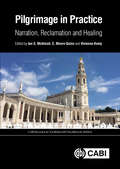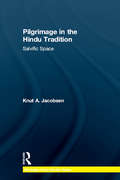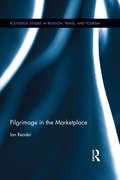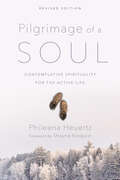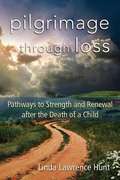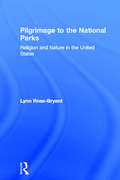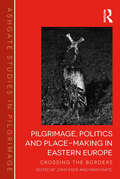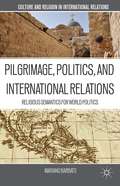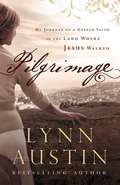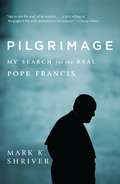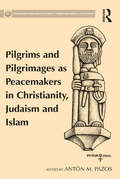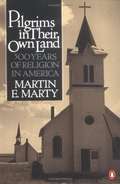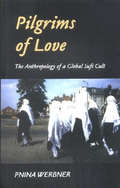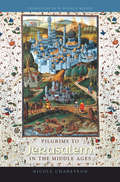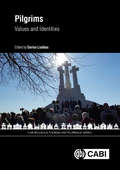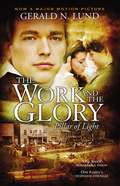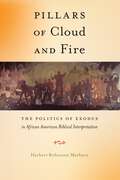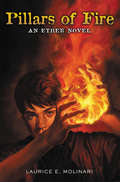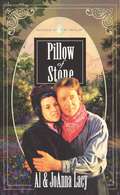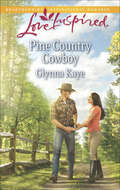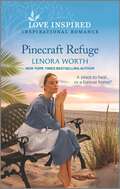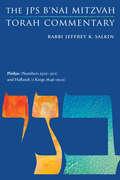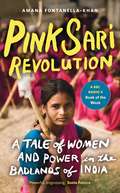- Table View
- List View
Pilgrimage in Practice: Narration, Reclamation and Healing (CABI Religious Tourism and Pilgrimage Series)
by Shirley Du Plooy Alison T. Smith E. Moore Quinn Vivienne Keely Matthew R. Anderson Mary Farrelly Tessa Garton George D. Greenia Richard LeSueur Dr Ian S. McIntosh Aateka Khan Suzanne Van BeekPilgrimage in Practice: Narration, Reclamation and Healing provides an interdisciplinary approach to the topic. It reveals many aspects of the practice of pilgrimage, from its nationalistic facets to its effect on economic development; from the impact of the internet to questions of globalization; from pilgrimage as protest to pilgrimage as creative expression in such media as film, art and literature. - Contests the very definitions of pilgrimage and challenges its paradigms. - Provides multiple perspectives on the subject to give a rounded and comprehensive review. - Covers past and present definitions of the sacred journey, the telling of stories, and historical injustices and their remedies through pilgrimage. Perhaps best understood as a form of heritage tourism or tourism with a conscience, pilgrimage (as with touristic travel) contains a measure of transformation that is often deep and enduring, making it a fascinating area of study. Reviewing social justice in the context of pilgrimage and featuring a diverse collection of interdisciplinary voices from across the globe, this book is a rich collection of papers for researchers of pilgrimage and religious and heritage tourism.
Pilgrimage in the Hindu Tradition: Salvific Space (Routledge Hindu Studies Series)
by Knut A. JacobsenSalvific space is one of the central ideas in the Hindu traditions of pilgrimage, and concerns the ability of space, especially sites associated with bodies of water such as rivers and lakes, to grant salvific rewards. Focusing on religious, historical and sociological questions about the phenomenon, this book investigates the narratives, rituals, history and structures of salvific space, and looks at how it became a central feature of Hinduism. Arguing that salvific power of place became a major dimension of Hinduism through a development in several stages, the book analyses the historical process of how salvific space and pilgrimage in the Hindu tradition developed. It discusses how the traditions of salvific space exemplify the decentred polycentrism that defines Hinduism. The book uses original data from field research, as well as drawing on main textual sources such as Mahābhārata, the Purāṇas, the medieval digests on pilgrimage places (tīrthas), and a number of Sthalapurāṇas and Māhātmyas praising the salvific power of the place. By looking at some of the contradictions in and challenges to the tradition of Hindu salvific space in history and in contemporary India, the book is a useful study on Hinduism and South Asian Studies.
Pilgrimage in the Marketplace: Pilgrimage In The Marketplace (Routledge Studies in Pilgrimage, Religious Travel and Tourism)
by Ian ReaderThe study of pilgrimage often centres itself around miracles and spontaneous populist activities. While some of these activities and stories may play an important role in the emergence of potential pilgrimage sites and in helping create wider interest in them, this book demonstrates that the dynamics of the marketplace, including marketing and promotional activities by priests and secular interest groups, create the very consumerist markets through which pilgrimages become established and successful – and through which the ‘sacred’ as a category can be sustained. By drawing on examples from several contexts, including Japan, India, China, Vietnam, Europe, and the Muslim world, author Ian Reader evaluates how pilgrimages may be invented, shaped, and promoted by various interest groups. In so doing he draws attention to the competitive nature of the pilgrimage market, revealing that there are rivalries, borrowed ideas, and alliances with commercial and civil agencies to promote pilgrimages. The importance of consumerism is demonstrated, both in terms of consumer goods/souvenirs and pilgrimage site selection, rather than the usual depictions of consumerism as tawdry disjunctions on the ‘sacred.’ As such this book reorients studies of pilgrimage by highlighting not just the pilgrims who so often dominate the literature, but also the various other interest groups and agencies without whom pilgrimage as a phenomenon would not exist.
Pilgrimage of a Soul: Contemplative Spirituality for the Active Life
by Shauna Niequist Phileena HeuertzPilgrimage of a Soul
Pilgrimage through Loss: Twelve Pathways to Strength and Renewal after the Death of a Child
by Linda Lawrence HuntThe death of a child immerses parents into a life-long challenge of living with one of life's most heartbreaking losses. Pilgrimage through Loss tells the story of one family's journey, along with interviews from thirty other mothers and fathers who add their voices to the silences that often surround suffering in our 'mourning-avoidant' culture. Hunt illuminates the varied pathways parents eventually discover that open their lives to strength and healing. Rather than prescribing a path that will lead to recovery, Hunt encourages parents to find the pathways that work for them as they seek to engage life again with meaning and hope. Each chapter includes questions for reflection and discussion, plus recent research on grief and loss. Pilgrimage through Loss not only helps grieving parents, it also provides an insightful resource for those wanting to understand and come alongside a family in grief.
Pilgrimage to the National Parks: Religion and Nature in the United States (Routledge Studies in Pilgrimage, Religious Travel and Tourism)
by Lynn Ross-BryantNational Parks – ‘America’s Best Idea’ – were from the first seen as sacred sites embodying the God-given specialness of American people and American land, and from the first they were also marked as tourist attractions. The inherent tensions between these two realities ensured the parks would be stages where the country’s conflicting values would be performed and contested. As pilgrimage sites embody the values and beliefs of those who are drawn to them, so Americans could travel to these sacred places to honor, experience, and be restored by the powers that had created the American land and the American enterprise. This book explores the importance of the discourse of nature in American culture, arguing that the attributes and symbolic power that had first been associated with the ‘new world’ and then the ‘frontier’ were embodied in the National Parks. Author Ross-Bryant focuses on National Parks as pilgrimage sites around which a discourse of nature developed and argues the centrality of religion in understanding the dynamics of both the language and the ritual manifestations related to National Parks. Beyond the specific contribution to a richer analysis of the National Parks and their role in understanding nature and religion in the U.S., this volume contributes to the emerging field of ‘religion and the environment,’ larger issues in the study of religion (e.g. cultural events and the spatial element in meaning-making), and the study of non-institutional religion.
Pilgrimage, Politics and Place-Making in Eastern Europe: Crossing the Borders (Routledge Studies in Pilgrimage, Religious Travel and Tourism)
by John Eade Mario KatićSince the beginning of the anthropology of pilgrimage, scant attention has been paid to pilgrimage and pilgrim places in central, eastern and south-eastern Europe. Seeking to address such a deficit, this book brings together scholars from central, eastern and south-eastern Europe to explore the crossing of borders in terms of the relationship between pilgrimage and politics, and the role which this plays in the process of both sacred and secular place-making. With contributions from a range of established and new academics, including anthropologists, historians and ethnologists, Pilgrimage, Politics and Place-Making in Eastern Europe presents a fascinating collection of case studies and discussions of religious, political and secular pilgrimage across the region.
Pilgrimage, Politics, and International Relations
by Mariano BarbatoA standout contribution to post-secular IR theory, this book addresses issues of global politics, from cooperation to conflict, and shows how a religious metaphor, the pilgrim, can help us to rethink our concepts of self, agency, and community in a time of changing world order.
Pilgrimage: My Journey to a Deeper Faith in the Land Where Jesus Walked
by Lynn AustinWe all encounter times when our spirit feels dry, when doubt looms.<P><P> The opportunity to tour Israel came at a good time. For months, my life has been a mindless plodding through necessary routine, as monotonous as an all-night shift on an assembly line. Life gets that way sometimes, when nothing specific is wrong but the world around us seems drained of color. Even my weekly worship experiences and daily quiet times with God have felt as dry and stale as last year's crackers. I'm ashamed to confess the malaise I've felt. I have been given so much. Shouldn't a Christian's life be an abundant one, as exciting as Christmas morning, as joyful as Easter Sunday? <P> With gripping honesty, Lynn Austin pens her struggles with spiritual dryness in a season of loss and unwanted change. Tracing her travels throughout Israel, Austin seamlessly weaves events and insights from the Word . . . and in doing so finds a renewed passion for prayer and encouragement for her spirit, now full of life and hope.
Pilgrimage: My Search for the Real Pope Francis
by Mark K. ShriverA down-to-earth and deeply intimate portrait of Pope Francis and his faith, based on interviews with the men and women who knew him simply as Jorge Mario Bergoglio Early on the evening of March 13, 2013, the newly elected Pope Francis stepped out onto the balcony of St. Peter's Basilica and did something remarkable: Before he imparted his blessing to the crowd, he asked the crowd to bless him, then bowed low to receive this grace. In the days that followed, Mark K. Shriver--along with the rest of the world--was astonished to see a pope who paid his own hotel bill, eschewed limousines, and made his home in a suite of austere rooms in a Vatican guesthouse rather than the grand papal apartment in the Apostolic Palace. By setting an example of humility and accessibility, Francis breathed new life into the Catholic Church, attracting the admiration of Catholics and non-Catholics alike. In Pilgrimage, Shriver retraces Francis's personal journey, revealing the origins of his open, unpretentious style and explaining how it revitalized Shriver's own faith and renewed his commitment to the Church. To help us understand how Jorge Mario Bergoglio became Pope Francis, Shriver travels to Bergoglio's native Argentina to meet with the people who knew him as a child, as a young Jesuit priest, and as a reformist bishop. Shriver visits the confessional where Bergoglio first felt called to a faith-based life and takes us to the humble parish where the future pontiff's pastoral career began: in a church created from a converted vegetable shed in an area just outside the city of Buenos Aires. In these impoverished surroundings, Bergoglio answered Christ's call to feed the hungry, clothe the naked, and shelter the homeless, following the example set by his papal namesake, St. Francis of Assisi. In this deeply reported yet highly personal book, Mark K. Shriver explores how Francis's commitment has struck a chord in the hearts of millions who long to make faith, love, humility, and mercy part of their lives as they go out into the world to serve and learn from the most marginalized.
Pilgrims Pray
by Fr. Thomas DubayIn a lucid style, Dubay explores the richness of scriptural prayer themes to be found in the biblical word.
Pilgrims and Pilgrimages as Peacemakers in Christianity, Judaism and Islam (Compostela International Studies in Pilgrimage History and Culture)
by Antón M. PazosPilgrimages can be analysed as acts of conflict - such as the Crusades - or also as platforms for relationship building and rapprochement between religions. With a set of contributions from leading experts in the field, this book explores the concept of pilgrimage in Christianity, Judaism and Islam. Some specific examples of pilgrimages that helped to strengthen links between different religions or civilisations are explored, ranging from Europe to Asia and from the Middle Ages to the twentieth century. Even though every pilgrimage that is investigated here has helped to link different worlds, the case studies show that this relationship rarely led to a better in inter-understanding. Nowadays, peaceful coexistence seems to be its greatest achievement.
Pilgrims in Their Own Land: 500 Years of Religion in America
by Martin E. Marty"Pilgrims in Their Own Land" is in one sense a study of migration, with each wave of immigrants bringing a set of religious beliefs to a new world. The narrative unfolds through sharply detailed biographical vignettes-stories of religious "pathfinders", including William Penn, Mary Baker Eddy, Henry David Thoreau, and many other leaders of movements, both marginal and mainstream. In addition, Marty considers the impact of religion on social issues such as racism, feminism, and utopianism. And engrossing, highly readable, and comprehensive history, "Pilgrims in Their Own Land" is written with respect, appreciation, and insight into the multitude of religious groups that represent expressions of spirituality in America.
Pilgrims of Love: The Anthropology of a Global Sufi Cult
by Pnina Werbner"... will be of interest not only to those concerned with Pakistan and the new Muslim presence in Europe, but also to those interested in an anthropological study of religion." --Barbara Metcalf, University of California, DavisPnina Werbner traces the development of a Sufi Naqshbandi order founded by a living saint, Zindapir, whose cult originated in Pakistan and has extended globally to Britain, Europe, the Middle East, and southern Africa. Drawing on 12 years of fieldwork in Pakistan and Great Britain, she elucidates the complex organization of Sufi orders as regional and transnational cults, and examines how such cults are manifested through ritual action and embodied in sacred mythology and global diasporas. A focus of the study is the key event in the order's annual ritual cycle, a celebration in which tens of thousands of people gather at the saint's lodge in Pakistan and in the streets of Britain. Werbner challenges accepted anthropological and sociological truths about Islam and modernity, and reflects on her own role as ethnographic observer. Pilgrims of Love is a major contribution to our understanding of disaporic Islamic practices, highlighting the vitality of Sufi orders in the postcolonial world.
Pilgrims to Jerusalem in the Middle Ages
by Nicole ChareyronAs medieval pilgrims made their way to the places where Jesus Christ lived and suffered, they experienced, among other things: holy sites, the majesty of the Egyptian pyramids (often referred to as the "Pharaoh's granaries"), dips in the Dead Sea, unfamiliar desert landscapes, the perils of traveling along the Nile, the customs of their Muslim hosts, Barbary pirates, lice, inconsiderate traveling companions, and a variety of difficulties, both great and small. In this richly detailed study, Nicole Chareyron draws on more than one hundred firsthand accounts to consider the journeys and worldviews of medieval pilgrims. Her work brings the reader into vivid, intimate contact with the pilgrims' thoughts and emotions as they made the frequently difficult pilgrimage to the Holy Land and back home again. Unlike the knights, princes, and soldiers of the Crusades, who traveled to the Holy Land for the purpose of reclaiming it for Christendom, these subsequent pilgrims of various nationalities, professions, and social classes were motivated by both religious piety and personal curiosity. The travelers not only wrote journals and memoirs for themselves but also to convey to others the majesty and strangeness of distant lands. In their accounts, the pilgrims relate their sense of astonishment, pity, admiration, and disappointment with humor and a touching sincerity and honesty.These writings also reveal the complex interactions between Christians, Jews, and Muslims in the Holy Land. Throughout their journey, pilgrims confronted occasionally hostile Muslim administrators (who controlled access to many holy sites), Bedouin tribes, Jews, and Turks. Chareyron considers the pilgrims' conflicted, frequently simplistic, views of their Muslim hosts and their social and religious practices.
Pilgrims: Values And Identities (CABI Religious Tourism and Pilgrimage Series)
by Rana P. Singh Josephine Pryce Dallen J Timothy Dr Daniel H Olsen Rubén C. Lois-González Pravin S. Rana Xosé M. Santos Dr Lucrezia Lopez Dane Munro Derek Dalton Rami Isaac Shin Yasuda Ali Thompson Kumi Kato María Ángeles Antelo Pedro Azevedo Luciana Thais Gonzalez Luis Alfonso Gómez Elyor E. Karimov Ricardo Nicolas Progano Xerardo Pereiro Kip Redick Larry Russell Augusta X. Thomson Slawoj TanasValues-rich journeys can be described as pilgrimage, spiritual travel, personal heritage tourism, holistic tourism, and valuistic journeys. There are many motivations for undertaking these journeys; the most important being personal values, life experience, personal and social identity, lifestyle, social and cultural influence. This book presents contributions that address pilgrim motivation, identity and values as they are shaped by the broader sociological, psychological, cultural and environmental perspectives. The focus of the book is the travellers themselves and their inner world through the lens of their pilgrimage. The research presented focuses on the typology of pilgrim journeys as ways in which identity and values are presented to a post-modern consumer society, providing interesting and challenging perspectives on the identity of pilgrims in the 21st century. The book: - Provides a framework for understanding the impact of values and identity on the motivation and behaviour of contemporary pilgrims. - Presents a comprehensive review of the latest research, a collection of case studies and models of practical applications. - Discusses the perceptions of tourism and pilgrimage in the age of value transformations and identity challenges.
Pillar of Light (The Work and the Glory # #1)
by Gerald N. LundWith more than two million copies of the nine-volume series in print since its initial release in 1990, The Work and the Glory is one of the most popular historical fiction series ever published by a religious publisher. Pillar of Light, volume one, is soon to be a major motion picture and will introduce this unforgettable story to a new generation of readers. In this saga of the Benjamin Steed family, award-winning author Gerald N. Lund blends historical reality and high-powered fiction to create an enduring love story full of intrigue, suspense, betrayal, and undeniable faith.
Pillars of Cloud and Fire: The Politics of Exodus in African American Biblical Interpretation (Religion and Social Transformation #8)
by Herbert Robinson MarburyAt the birth of the United States, African Americans were excluded from the newly-formed Republic and its churches, which saw them as savage rather than citizen and as heathen rather than Christian. Denied civil access to the basic rights granted to others, African Americans have developed their own sacred traditions and their own civil discourses. As part of this effort, African American intellectuals offered interpretations of the Bible which were radically different and often fundamentally oppositional to those of many of their white counterparts. By imagining a freedom unconstrained, their work charted a broader and, perhaps, a more genuinely American identity. In Pillars of Cloud and Fire, Herbert Robinson Marbury offers a comprehensive survey of African American biblical interpretation. Each chapter in this compelling volume moves chronologically, from the antebellum period and the Civil War through to the Harlem Renaissance, the civil rights movement, the black power movement, and the Obama era, to offer a historical context for the interpretative activity of that time and to analyze its effect in transforming black social reality. For African American thinkers such as Absalom Jones, David Walker, Zora Neale Hurston, Frances E. W. Harper, Adam Clayton Powell, and Martin Luther King, Jr., the exodus story became the language-world through which freedom both in its sacred resonance and its civil formation found expression. This tradition, Marbury argues, has much to teach us in a world where fundamentalisms have become synonymous with “authentic” religious expression and American identity. For African American biblical interpreters, to be American and to be Christian was always to be open and oriented toward freedom.
Pillars of Fire
by Laurice Elehwany MolinariAfterVero Leland discovered his true identity in book one, he must continue to maintain his life on earth as a regular 12-year-old kid, which is hard to do when you are really a fledgling, a guardian angel in training to become one of the fiercest of all angels. At any moment, he could be called to the Ether, the spiritual realm surrounding the earth, where he must face whatever trials come his way in angel school, aka C.A.N.D.L.E. (the Cathedral of Angels for Novice Development, Learning and Edification). In book two, part of Vero’s training involves the Angel Trials, a set of three challenges where he and his group of fellow fledglings compete with angels from other realms. But while he is competing in the Ether, back on earth his sister is in trouble. She has a new friend who is leading her down the wrong path. During the third trial, Vero realizes he must choose between saving his sister or winning his competition. But the attack on Clover is only a means to get to Vero, and he finds himself face-to-face with an evil even greater than what he experienced in the Bottomless Pit. Once again, he is tested beyond what any previous fledgling has endured, and how the battle ends will affect not only his grade in C.A.N.D.L.E., but also the fate of the world.
Pillow of Stone (Hannah of Fort Bridger Series #4)
by Al LacyNew Orleans, 1870. With her infant daughter Larissa, Julianna LeCroix heads west to begin a new life in Idaho after unscrupulous lawyers steal her inheritance following her husband's death. Along the way she encounters kind strangers who share the gospel with her, and a desperate drifter named Jack Bower who takes her hostage to conceal his identity from hired killers hot on his trail. As he travels with Julianna, Jack finds himself falling in love with the spirited and beautiful young widow. He hires on with a local rancher, becomes a Christian, and eventually asks Julianna to marry him-just before the stagecoach that would separate them forever heads for the horizon!From the Trade Paperback edition.
Pine Country Cowboy: The Shepherd's Bride Rescued By The Firefighter Pine Country Cowboy
by Glynna KayeA brokenhearted librarian learns to love again with the help of a handsome cowboy in this inspirational romance. Abby Diaz longs to reestablish a relationship with her father, so she heads to Canyon Springs, her Arizona hometown, with a painful past she can’t share with anyone. But then she’s needed to care for her young nephew. The little boy takes a shine to a happy-go-lucky cowboy, a handsome man who’s everything Abby can never have. The more time she spends with Brett, the more she realizes he’s harboring a heartache of his own. As she works on repairing family ties with her father, Abby knows that opening up to Brett is key to forging a new future . . . together.
Pinecraft Refuge: An Uplifting Inspirational Romance (Pinecraft Seasons #1)
by Lenora WorthCan an escape from her present… Become the future she&’s always wanted? When her doctor prescribes fresh air and sunshine, Eva Miller turns her Florida getaway into a chance to gain some independence. Only, working part-time for Amish shop owner Tanner Dawson is hardly a vacation. The overprotective single father reminds Eva of her own strict upbringing. But as she begins to see beneath his gruff exterior, can she trust Tanner—and her heart—enough to stay?From Love Inspired: Uplifting stories of faith, forgiveness and hope.Pinecraft Seasons Book 1: Pinecraft Refuge
Ping-Pong Shabbat: The True Story of Champion Estee Ackerman
by Ann D. KoffskyPOP POP KERPOW!Eleven-year-old Ping-Pong phenom Estee Ackerman must make a difficult choice. When her championship match is scheduled on the Jewish Sabbath, will she go for the gold medal, or honor her faith? Read the true story of how a young girl struggled to uphold her beliefs while pursuing her passion.Tournament after tournament, Estee kept winning.She beat all sorts of players. Some were older. Some were younger. She even beat tennis star Rafael Nadal! She became one of the best Ping-Pong players in the United States.Estee Ackerman loved Ping-Pong more than anything. But she also loved and honored the Jewish tradition of the Sabbath. At age eleven, she began to rise in the ranks of tournament players, making it all the way to the finals of the US National Table Tennis Championships. She only had one player left to beat to win a gold medal--but the final match was set during Shabbat, and the judges said they couldn't change it. How could Estee choose between her passion and her faith? This is the true story of a girl's struggle between her love for her religion and her love of the game.
Pinhas: The JPS B'nai Mitzvah Torah Commentary (JPS Study Bible)
by Rabbi Jeffrey K. SalkinPinhas (Numbers 25:10-30:1) and Haftarah (1 Kings 18:46-19:21): The JPS B’nai Mitzvah Torah Commentary shows teens in their own language how Torah addresses the issues in their world. The conversational tone is inviting and dignified, concise and substantial, direct and informative. Each pamphlet includes a general introduction, two model divrei Torah on the weekly Torah portion, and one model davar Torah on the weekly Haftarah portion. Jewish learning—for young people and adults—will never be the same. The complete set of weekly portions is available in Rabbi Jeffrey K. Salkin’s book The JPS B’nai Mitzvah Torah Commentary (JPS, 2017).
Pink Sari Revolution: A Tale of Women and Power in the Badlands of India
by Amana Fontanella-KhanWhen Sheelu was arrested for stealing from a powerful politician in the notoriously crooked region of Uttar Pradesh, she was sure that she would be forced to accept a prison sentence, not least because she had alleged that she had been assaulted by a man in the politician's household. But then Sampat Pal heard word of the charges, and the formidable commander of the pink-sari-wearing, pink-baton-wielding, 20,000-strong 'Pink Gang' decided to shake things up. Narrating the story of Sampat Pal and the Pink Gang's fight for Sheelu, as well as for others facing injustice and oppression, journalist Amana Fontanella-Khan delivers a riveting portrait of women grabbing fate with their own hands - and winning back their lives.
